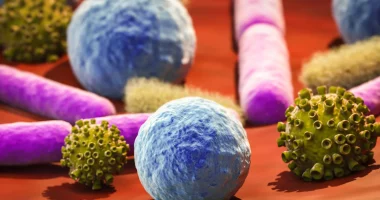Behçet’s disease, or Behçet’s syndrome, is a condition where the body’s blood vessels get inflamed for a long time. When this happens, it can cause various issues like problems with blood vessels, sores in the mouth, genitals, and skin, inflammation in the eyes, joint pain, and inflammation in the brain, gut, and spinal cord.
This condition can come and go in phases. Sometimes, there may be no symptoms at all, but during a flare-up, the symptoms can get worse for a bit before getting better again.
Treatment
Treatment for Behçet’s disease aims to manage symptoms since there’s no cure available. However, various therapies and lifestyle adjustments can be beneficial in easing symptoms and improving the quality of life for individuals with the condition.
The National Institute of Arthritis and Musculoskeletal and Skin Diseases (NIAMS) recommends a combination of exercise and rest to alleviate pain and reduce the risk of further complications. This approach can help individuals maintain mobility and overall well-being.
Once someone receives a diagnosis of Behçet’s disease, a group of doctors will collaborate to develop a personalized treatment plan. This group typically includes specialists such as oral health professionals, ophthalmologists, dermatologists, rheumatologists, and others. Each member plays a crucial role in addressing specific symptoms and providing comprehensive care tailored to the individual’s needs.
Drug therapies
Drug therapies for Behçet’s disease encompass various medications aimed at managing symptoms and controlling the underlying inflammation. As stated by the United Kingdom’s National Health Service (NHS), these medications involve corticosteroids, which can be administered systemically or applied topically to address inflammation, particularly in the case of oral sores. Immunosuppressants are also utilized to dampen the overactive immune response responsible for many of the disease’s manifestations. Additionally, biological therapies offer a more targeted approach by addressing particluar biological processes contributing to symptoms. For instance, TNFa-inhibitors focus on mitigating inflammation by targeting specific antibodies.
Topical therapy involves the application of medications directly to affected areas of the body. This may include pain-relieving treatments such as corticosteroid rinses, eye drops, gels, and ointments, such as triamcinolone acetonide, dexamethasone, and betamethasone.
Oral therapy can be necessary for widespread symptoms, with medications like colchicine, corticosteroids, and immunosuppressive drugs like cyclosporine, azathioprine, and cyclophosphamide, which modulate immune activity throughout the body. Additional medications may be prescribed based on the individual’s symptoms, and treatment options should be discussed thoroughly with a healthcare professional.
During pregnancy
During pregnancy, managing Behçet’s disease poses unique considerations due to the potential harm medications may pose to the unborn baby. While Behçet’s itself isn’t typically associated with pregnancy complications, the medications used to manage it can be risky. Thus, it’s advisable for individuals planning pregnancy to consult with their healthcare provider beforehand to discuss potential risks and develop a safe treatment plan. In rare cases, neonatal Behçet’s disease may occur, but it usually resolves within 6 to 8 weeks after birth.
Lifestyle tips
Maintaining a balanced and diverse diet, rich in vegetables and fruits while limiting foods high in sugar or fat, is essential for overall health. However, for some individuals with Behçet’s disease, certain foods may potentially trigger flare-ups. In a study, scientists discovered that specific items exacerbated Behçet’s-related mouth ulcers in a significant portion of respondents. These items included pineapple, certain cheeses like Emmental, various nuts such as peanuts and almonds, and lemon.
To pinpoint potential triggers, some individuals find it helpful to temporarily eliminate suspect foods from their diet, such as nuts, pineapple, or cheese. By doing so, they can observe whether symptoms improve, providing valuable insight into dietary sensitivities.
Furthermore, fatigue and stress were identified by a substantial percentage of participants in the same study as exacerbating symptoms. Managing stress and ensuring adequate rest are crucial aspects of self-care for individuals with Behçet’s disease.
Before incorporating any complementary or supplement therapies into their regimen, individuals should consult with a healthcare provider. This step is important to avoid exacerbating symptoms or potential interactions with existing treatments. A healthcare provider can offer guidance on safe and effective approaches to managing Behçet’s disease symptoms.
Causes
Behçet’s disease is a condition where the body’s immune system mistakenly attacks healthy tissues, causing inflammation. Though its exact cause is unknown, experts believe it’s an autoimmune disease.
Anyone can get Behçet’s disease, but it’s more common in individuals in their 20 and 30 years. Men tend to have more severe signs than women.
Where you live and your ethnicity might affect your chances of getting Behçet’s disease. It’s most normal in men from the Asia and Middle East and women from the US, other Western countries, Korea, and Japan.
Genetics may also play a role. This means that if someone in your family has Behçet’s disease, you might be more likely to get it too. Scientists also think viruses, or bacteria, things in the environment could be connected to the disease, but more research is needed to be sure.
Symptoms
Behçet’s disease varies from person to person, with symptoms often fluctuating over weeks. Sometimes, symptoms can even vanish without medication.
Symptoms affect different parts of the body. Mouth sores are usually the first sign, appearing as painful ulcers on the tongue, gums, lips, and other areas inside the mouth. These sores can be small or large, shallow or deep, and typically heal within a few weeks, sometimes leaving scars.
Genital sores are common, with over half of those with Behçet’s experiencing them. Males may have ulcers on the penis or scrotum, while females may have them on the vagina, vulva, or cervix. These sores can be painful and may scar after healing.
Skin problems like red and tender nodules, known as erythema nodosum, are also common. Eye inflammation, called uveitis, can cause pain, blurred vision, and even blindness if not treated promptly. Inflammation of arteries and veins can lead to blood clots and other serious complications.
Joint inflammation, or arthritis, can cause pain and swelling in joints like knees and wrists, but it usually goes away within a few weeks without causing permanent damage. Gut ulcers can lead to symptoms like vomiting and rectal bleeding, while lung problems and inflammation of the brain and brain stem can cause various symptoms, including headaches and difficulty with coordination.
Certain symptoms, like fever and stiff neck, may indicate serious complications like inflammation of the brain stem, which can lead to stroke if left untreated. It’s essential to report such symptoms to healthcare providers immediately for proper evaluation and treatment.
Diagnosis
Diagnosing Behçet’s disease isn’t straightforward because there isn’t one specific test for it. Doctors have to eliminate other conditions that might look like Behçet’s disease.
To diagnose Behçet’s disease, doctors follow certain rules. First, the person must have had mouth ulcers at least three times in a year. Then, they must have at least two of the following:
- Recurring ulcers in the genital area.
- Inflammation in the eyes, which the doctor confirms with an eye exam.
- Skin sores in elders who aren’t using corticosteroids.
- A positive result in a test called a pathergy test.
In the pathergy test, the doctor uses a small, clean needle to prick the skin on the forearm. If a small red bump appears on the skin within 1 to 2 days, it’s a positive result.
Outlook
Behçet’s disease sticks around for life, but that doesn’t mean life stops. Many individuals with Behçet’s can live their lives fully and get things done, as per the American Behçet’s Association.
Taking medicine can help with the pain, keep symptoms in check, and even make those times when symptoms act up less often and not as bad.
Summary
Behçet’s disease is an autoimmune condition causing inflammation, with varied symptoms affecting the mouth, genitals, skin, eyes, joints, gut, lungs, and nervous system. Diagnosis involves ruling out other conditions and meeting specific criteria like recurrent mouth ulcers and additional symptoms. While there’s no cure, treatments focus on managing symptoms with medications, lifestyle changes, and therapies tailored to individual needs.
Despite being a lifelong condition, many people with Behçet’s can lead productive lives. Regular medical care and prompt reporting of symptoms are essential for managing the disease and preventing complications. Overall, a comprehensive approach involving healthcare providers, lifestyle adjustments, and effective symptom management can enhance the outlook for individuals living with Behçet’s disease.









